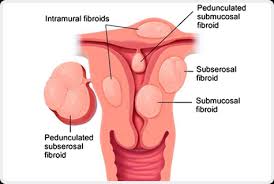Uterine fibroid embolization (UFE) is a procedure done by a radiologist. It blocks blood flow to fibroids in the uterus. (It is also called uterine artery embolization.) For women who are not planning a pregnancy in the future, UFE is a possible option in place of surgery for fibroids.
Follow your physician’s instructions exactly about when to stop eating and drinking, or your procedure may be canceled. If your doctor has instructed you to take your medicines on the day of your procedure, do so using only a sip of water. About an hour before the procedure, you may be given a sedative to help you relax. The sedative will not put you to sleep, but only help you to relax.
Anatomy
Uterine fibroids are benign tumors in the middle layer of the uterus, the muscular layer that causes contractions during labor.
A tumor is an abnormal growth of cells and tissue. Benign tumors are non-cancerous and do not spread. Cancers are called malignant tumors because they do spread to other parts of the body.
Uterine fibroids are made of nodules of smooth muscle cells and fibrous tissue that develop in the wall of the uterus. Fibroids may grow as a single nodule or in clusters. They may range in size from 1/10 of an inch to 8 inches in diameter. Uterine fibroids may grow in the wall of the uterus, or they may project into the interior cavity or toward the outer surface of the uterus.

Causes
The factors that cause fibroids to grow in the uterus are not known.
Almost all fibroids occur in women of reproductive age or old enough to have periods. About 25% of women of reproductive age have fibroids.
Athletic women seem to have a lower prevalence of uterine fibroids than women who do not engage in any athletic activities.
Similarly, overweight women are more likely to have fibroids. Women who have given birth appear to be at a lower risk for fibroids.
Symptoms
Most fibroids don’t cause symptoms—only 10 to 20 percent of women who have fibroids require treatment. Depending on size, location and number of fibroids, they may cause:
- Heavy, prolonged menstrual periods and unusual monthly bleeding, sometimes with clots; this can lead to anemia
- Pelvic pain and pressure
- Pain in the back and legs
- Pain during sexual intercourse
- Bladder pressure leading to a frequent urge to urinate
- Pressure on the bowel, leading to constipation and bloating
- Abnormally enlarged abdomen
Uterine Fibroid Embolization
Diagnosis
Family doctors and gynecologists can diagnose fibroids fairly easily after obtaining a detailed medical history and performing a pelvic exam. Fibroids are the most frequently diagnosed tumor of the female pelvis.
Ultrasounds of the pelvis may be needed in order to see the fibroids better.
MRIs and CAT scans may also be done.

Treatment
Uterine fibroid embolization (UFE), also known as uterine artery embolization, is performed by an interventional radiologist, a physician who is trained to perform this and other types of embolization and minimally invasive procedures. It is performed while the patient is conscious, but sedated and feeling no pain. It does not require general anesthesia. The interventional radiologist makes a tiny nick in the skin in the groin and inserts a catheter into the femoral artery. Using real-time imaging, the physician guides the catheter through the artery and then releases tiny particles, the size of grains of sand, into the uterine arteries that supply blood to the fibroid tumor. This blocks the blood flow to the fibroid tumor and causes it to shrink and die.

Am I at Risk?
Fibroids, which grow in the muscle layers of the uterus and also on the cervix, are the most common pelvic tumors in women. About 80% of women develop at least one fibroid in the uterus by menopause.
Most fibroids don’t cause problems. (Fewer than 0.5% are cancerous.) But depending on where they grow, fibroids may cause back pain, constipation, cramping, anemia, pain during sex, and heavy, long periods. They can also make it harder for a woman to conceive and carry a pregnancy to term.
Risk factors for fibroids do include family history, as well as race — African-American women get fibroids more often, earlier, and more severely than white women. Other factors include having your first period before age 10, never giving birth, and having high blood pressure.

Fibroid Descriptions
Prevalence of Uterine Fibroids
 Twenty to 40 percent of women age 35 and older have uterine fibroids of a significant size. African American women are at a higher risk for fibroids: as many as 50 percent have fibroids of a significant size. Uterine fibroids are the most frequent indication for hysterectomy in premenopausal women and, therefore, are a major public health issue. Of the 600,000 hysterectomies performed annually in the United States, one-third are due to fibroids.
Twenty to 40 percent of women age 35 and older have uterine fibroids of a significant size. African American women are at a higher risk for fibroids: as many as 50 percent have fibroids of a significant size. Uterine fibroids are the most frequent indication for hysterectomy in premenopausal women and, therefore, are a major public health issue. Of the 600,000 hysterectomies performed annually in the United States, one-third are due to fibroids.
Subserosal Fibroids
These develop under the outside covering of the uterus and expand outward through the wall, giving the uterus a knobby appearance. They typically do not affect a woman’s menstrual flow, but can cause pelvic pain, back pain and generalized pressure. The subserosal fibroid can develop a stalk or stem-like base, making it difficult to distinguish from an ovarian mass. These are called pedunculated. The correct diagnosis can be made with either an ultrasound or magnetic resonance (MR) exam.
Intramural Fibroids
These develop within the lining of the uterus and expand inward, increasing the size of the uterus, and making it feel larger than normal in a gynecologic internal exam. These are the most common fibroids. Intramural fibroids can result in heavier menstrual bleeding and pelvic pain, back pain or the generalized pressure that many women experience.
Submucosal Fibroids
These are just under the lining of the uterus. These are the least common fibroids, but they tend to cause the most problems. Even a very small submucosal fibroid can cause heavy bleeding – gushing, very heavy and prolonged periods.
F.A.Q.
Schedule an Appointment
At Precision VIR, our specialists will take the time to answer your questions about fibroids and UFE. If you are suffering from fibroids, please make an appointment for a free phone consult with one of our specialists who can advise you on your treatment.
If you are experiencing symptoms due to fibroids, you may be a candidate for Uterine Fibroid Embolization (UFE). Our top fibroid specialists at Precision VIR will take the time to answer your questions about the UFE procedure. Call us at 214-382-3200 or complete the form below.
Precision VIR serves the DFW area including Dallas, Fort Worth, Carrollton, Richardson, Garland, Mesquite, Highland Park, University Park, Park Cities, Plano, Frisco, Allen, McKinney, Arlington, Irving, Grand Prairie, Flower Mound, Denton, Lewisville and all of North Texas.
This information is not a substitute for professional medical advice. Prior to starting any new treatment or questions regarding a medical condition, always seek the advice of your doctor or other qualified health provider.

